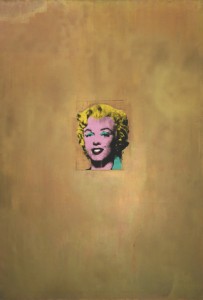On a week-long trip to NYC, my travelling partner and I decided that we had no interest in culture this time around, and would spend the entire trip indulging in fabulousness (think daily mani-pedis, cocktails galore and endless lobster). After 4 days our bank balances were stripped bare, our nails still looked immaculate from the first mani-pedi, and our livers were starting to ache somewhat. So, I decided that the only solution was for me to head to MoMA. Remembering that Random International’s Rain Room (2012) had relocated to town, I was adamant that my day would include not being rained on in the name of art, and promptly slotted this into our elaborate plans.
Entering solo (my travelling companion preferred to hit Saks Beauty and Accessories over mechanically induced rain), I paid my fee (a mere $14 for a student), and found my way to the line for Rain Room. It looked pretty short, and I felt fairly smug. But only for a short period of time. The attendant came over and informed us that the wait was 3 hours. The gallery closed in 3 hours and so we weren’t even guaranteed entry should we wait 180 minutes in blazing heat. I made a run for it.
Making a run for it clutching a day pass to the greatest modern art gallery on earth is not a bad way to go. Unfortunately, I’d made plans to meet my friend an hour from our departure, which gave me around 35 minutes. I choicely picked Painting & Sculpture (my favourite floor includes Warhol, Dan Flavin, Donald Judd, Yayoi Kusama, Jackson Pollock and Rosenquist) and spent my time dreamily wandering through the huge white rooms.
In a world saturated by images, Warhol’s work loses some of its power whilst gaining more credibility for foreseeing the phenomenon. His “Gold Marilyn Monroe” (1962) is so bold, and so easy to appreciate amongst the more abstract minimalist works of the same floor. And yet there is so much more beneath the surface. She’s a brand, but an idol. She’s Art, but she’s questioning Art too. She’s gold and appealing, but she’s also just committed sinister suicide. She’s the American Dream: shattered.
It’s a beautifully simple composition, and made all the better for the absence of the three hour wait. Duly satisfied by a short period of time with my favourite works, I trotted off to Saks to dissuade my friend from buying a hideous (and very expensive) handbag. On the walk over, I couldn’t help but wonder why we bother with these blockbuster exhibitions. The long queues, the jam-packed rooms and the absence of any guarantee that we will enjoy the work don’t make for a particularly outing. In London, we even pay out of our eyeballs for such exhibitions (think of the recent Tate Modern Damien Hirst bonanza if you’re short of inspiration). It’s the same phenomenon which is credited with the ‘rotting of society’, the cult of celebrity. The art world holds itself above such frivolity, or at least appears to, and yet charges exorbitant amounts of money to see an exhibition which can only be credited with fame, not necessarily with greater merit than the permanent exhibitions.
Does the phenomenon of blockbuster exhibitions discourage museum visitors from engaging with the permanent collections? Does it start to disregard the rich and varied heritage from which the new exhibitions were born? Does it encourage people to engage with a ‘Oh, I’ve seen that and so I know that’ attitude; the one which makes everyone an expert on whatever painting they’ve glanced at one time in their life. We are far from encouraged to repeatedly visit our favourite room of a gallery, or to fawn over our favourite sculpture.
Despite my initial disappointment at having missed Rain Room both in London and in New York, I was swiftly consoled by memories of my very favourite works in the world. Big exhibitions might encourage people to visit galleries, but it’s for the wrong reasons.



